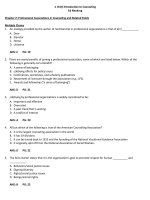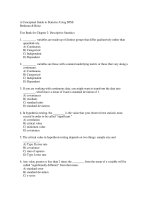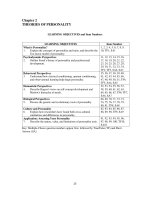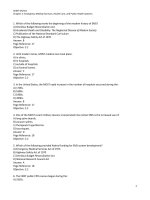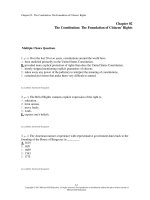Advanced EMT a clinical reasoning approach 1st edition alexander test bank
Bạn đang xem bản rút gọn của tài liệu. Xem và tải ngay bản đầy đủ của tài liệu tại đây (333.08 KB, 9 trang )
AEMT MyTest
Chapter 2: Emergency Medical Services, Health Care, and Public Health Systems
1. Which of the following marks the beginning of the modern history of EMS?
A) Omnibus Budget Reconciliation Act
B) Accidental Death and Disability: The Neglected Disease of Modern Society
C) Publication of the National Standard Curriculum
D) The Highway Safety Act of 1970
Answer: B
Page Reference: 17
Objective: 2.2
2. Until modern times, MOST medical care took place:
A) in clinics.
B) in hospitals.
C) outside of hospitals.
D) at funeral homes.
Answer: C
Page Reference: 17
Objective: 2.2
3. In the United States, the MOST rapid increase in the number of hospitals occurred during the:
A) 1700s.
B) 1800s.
C) 1900s.
D) 2000s.
Answer: B
Page Reference: 17
Objective: 2.2
4. One of the MOST recent military lessons incorporated into civilian EMS is the increased use of:
A) long spine boards.
B) vacuum splints.
C) therapeutic hypothermia.
D) tourniquets.
Answer: D
Page Reference: 18
Objective: 2.2
5. Which of the following provided federal funding for EMS system development?
A) Emergency Medical Services Act of 1973
B) Highway Safety Act of 1970
C) Omnibus Budget Reconciliation Act
D) National Research Council Act
Answer: A
Page Reference: 18
Objective: 2.2
6. The FIRST public CPR courses began during the:
A) 1950s.
1
AEMT MyTest
Chapter 2: Emergency Medical Services, Health Care, and Public Health Systems
B) 1960s.
C) 1970s.
D) 1980s.
Answer: B
Page Reference: 19
Objective: 2.2
7. The author of the FIRST paramedic textbook was:
A) Jeff Clawson.
B) R. Adams Cowley.
C) Norman McSwain.
D) Nancy Caroline.
Answer: D
Page Reference: 20
Objective: 2.2
8. _______________ developed the FIRST set of standardized dispatch protocols in 1978, which have evolved
into the widely used Medical Priority Dispatch System.
A) Jeff Clawson
B) R. Adams Cowley
C) Norman McSwain
D) Nancy Caroline
Answer: A
Page Reference: 20
Objective: 2.2
9. ______________ developed the concept of the “Golden Hour” and was instrumental in the development of
one of the FIRST air EMS services in the country through the Maryland State Police.
A) Jeff Clawson
B) R. Adams Cowley
C) Norman McSwain
D) Nancy Caroline
Answer: B
Page Reference: 20
Objective: 2.2
10. _____________ was the founding executive director of the NREMT and instrumental in developing the
NAEMT.
A) Rocco Morando
B) James O. Page
C) Peter Safar
D) Norman McSwain
Answer: A
Page Reference: 20
Objective: 2.2
2
AEMT MyTest
Chapter 2: Emergency Medical Services, Health Care, and Public Health Systems
11. _______________ introduced the concept of airway, breathing, and circulation (ABCs) in CPR in the 1950s.
A) Rocco Morando
B) James O. Page
C) Peter Safar
D) Norman McSwain
Answer: C
Page Reference: 20
Objective: 2.2
12. _______________ was an EMS pioneer in the Los Angeles County Fire Department and founder of the
Journal of Emergency Medical Services (JEMS).
A) Rocco Morando
B) James O. Page
C) Peter Safar
D) Norman McSwain
Answer: B
Page Reference: 20
Objective: 2.2
13. The Statewide Technical Assistance Program Assessment Standards specifies that all personnel who staff
ambulances MUST be trained to the:
A) Emergency medical responder level.
B) Emergency medical technician level.
C) Advanced emergency medical technician level.
D) Paramedic level.
Answer: B
Page Reference: 21
Objective: 2.3
14. Which of the following statements regarding the Statewide Technical Assistance Program Assessment
Standards requirements for patient transport is CORRECT?
A) EMS providers should participate in public education activities.
B) Adequate communication must allow access by the public to EMS services.
C) A physician is required to provide patient care oversight.
D) The patient should be transported to an appropriate facility in a timely manner.
Answer: D
Page Reference: 21
Objective: 2.3
15. The National Registry of Emergency Medical Technicians was founded to establish which of the following?
A) An education curriculum for EMT courses
B) Quality oversight of emergency medical services practices
C) Professional standards for emergency medical services personnel
D) Quality Assurance programs for emergency medical services
Answer: C
Page Reference: 19
Objective: 2.2
3
AEMT MyTest
Chapter 2: Emergency Medical Services, Health Care, and Public Health Systems
16. The purpose of the ‘Statewide Technical Assistance Program Assessment Standards’ is to:
A) set standards to evaluate statewide EMS systems.
B) provide standards for medical direction physicians.
C) provide guidance for development of EMS testing standards.
D) provide funding for trauma system development.
Answer: A
Page Reference: 21
Objective: 2.3
17. The national EMS education program-accrediting organization is the:
A) NHTSA.
B) DOT.
C) NREMT.
D) CoAEMSP.
Answer: D
Page Reference: 22
Objective: 2.2
18. When a local government requests competitive bids for an outside company to provide EMS service, the
model is called:
A) hospital based.
B) privatization.
C) third service.
D) fire based.
Answer: B
Page Reference: 23
Objective: 2.4
19. Which of the following represents a public safety model of EMS?
A) Fire based service
B) Private service
C) Municipal third service
D) Tiered service
Answer: C
Page Reference: 23
Objective: 2.4
20. Which of the following allows for the greater geographic mobility within the EMS profession?
A) Increased employee retention rates
B) Higher pay scale
C) Standardized testing
D) Improvements in reciprocity
Answer: D
Page Reference: 25
Objective: 2.13
4
AEMT MyTest
Chapter 2: Emergency Medical Services, Health Care, and Public Health Systems
21. A call to 911 is answered at a PSAP. What exactly is a PSAP?
A) Professional Security Access Place
B) Public Safety Answering Point
C) Personal Safety Access Point
D) Public Safety Access Point
Answer: B
Page Reference: 25
Objective: 2.5
22. Which of the following is part of the Enhanced 911 system?
A) Providing automatic call-back
B) Automatically dispatching an ambulance
C) Dispatching law enforcement
D) Identifying the caller’s location
Answer: D
Page Reference: 25
Objective: 2.5
23. Which of the following patients would benefit the MOST by calling an enhanced 911 system?
A) A patient with chest pain
B) A patient with an acute onset of confusion
C) A patient who cannot reach his phone
D) A patient with a broken arm
Answer: A
Page Reference: 25
Objective: 2.5
24. Which of the following allows vehicles to be continuously positioned in close proximity to where EMS calls
are expected to occur at certain times of day, based on historical statistics for the system?
A) System Status Management
B) Global Positioning System
C) Public Safety Placement System
D) Enhanced Vehicle Status Management
Answer: A
Page Reference: 25
Objective: 2.1
25. Which of the following typically presents a problem that occurs when someone calls 911 with a cell phone?
A) Determining the type of emergency
B) Background noise and interference
C) Determining the location of the caller
D) Verifying the type of response needed
Answer: C
Page Reference: 25
Objective: 2.5
5
AEMT MyTest
Chapter 2: Emergency Medical Services, Health Care, and Public Health Systems
26. A common system standard for ALS service is to respond to _____ percent of calls in _____ minutes or less.
A) 60, 6
B) 70, 7
C) 80, 8
D) 90, 9
Answer: C
Page Reference: 25
Objective: 2.3
27. Which person within the EMS system is responsible for approving EMS providers to practice within the
system?
A) Service manager
B) Medical director
C) Clinical coordinator
D) State EMS office
Answer: B
Page Reference: 25
Objective: 2.10
28. Medical direction that takes place in the form of protocols and standing orders is considered:
A) online.
B) prospective.
C) direct.
D) passive.
Answer: B
Page Reference: 26
Objective: 2.10
29. Which of the following would be an EMS public health initiative?
A) Volunteering to raise money for a sick child
B) Setting up free blood pressure screenings
C) Purchasing equipment with new technology
D) Working extra shifts to cover for an injured employee
Answer: B
Page Reference: 26
Objective: 2.9
30. Your patient complains of substernal chest pain radiating to her back. You treat her according to your chest
pain protocol, but she doesn’t get any relief. You learn later that she also had low blood sugar but you didn’t
check her blood glucose level. You feel like you need to learn more about what happened with this patient. You
should:
A) call the patient’s family.
B) ask a coworker.
C) speak to your medical director.
6
AEMT MyTest
Chapter 2: Emergency Medical Services, Health Care, and Public Health Systems
D) ask to see the patient’s hospital report.
Answer: C
Page Reference: 26
Objective: 2.11
31. After every patient transport, your EMS service mails the patient a questionnaire asking about the care
provided by the company. This is an example of:
A) continuous quality improvement.
B) retrospective analysis.
C) performance benchmarks.
D) Quality Assurance planning.
Answer: A
Page Reference: 26
Objective: 2.12
32. The EMS Agenda for the Future calls for a greater role of EMS in:
A) interfacility transport.
B) developing national protocols.
C) providing home health care.
D) health care and public health.
Answer: D
Page Reference: 26
Objective: 2.9
33. One example of integrating EMS into the overall health care system would be to:
A) allow out-of-state EMS providers to provide care in disasters.
B) have AEMTs practice as paramedics in the emergency department.
C) plan training meetings with the medical director.
D) require all EMS provides to dress in similar uniforms.
Answer: A
Page Reference: 27
Objective: 2.7
34. In which of the following areas would you MOST likely find a neonatal intensive care unit?
A) Community hospital
B) Critical access hospital
C) Large city hospital
D) Urgent care center
Answer: C
Page Reference: 27
Objective: 2.6
35. One of EMS’s greatest challenges as it moves into the future will be to:
A) write new statewide protocols.
B) educate the public about EMS.
C) develop new leaders.
D) get approval for a national pay scale.
7
AEMT MyTest
Chapter 2: Emergency Medical Services, Health Care, and Public Health Systems
Answer: C
Page Reference: 27
Objective: 2.13
36. A small rural hospital that provides 24-hour emergency care to stabilize critical patients for transfer to a
higher level of care is an example of which of the following?
A) Community access hospital
B) Critical access hospital
C) Regional trauma center
D) Level III treatment center
Answer: B
Page Reference: 26
Objective: 2.1
37. Which of the following would be an example of retrospective medical direction?
A) Yearly refresher training on medication administration
B) Training meetings to review new protocols
C) Calling the hospital for orders to restrain a violent patient
D) Medical director reviewing all stroke calls for the prior month
Answer: D
Page Reference: 26
Objective: 2.11
38. Which of the following would be of particular concern to the public health system?
A) A major earthquake near a metropolitan area
B) An outbreak of mumps passed through a family
C) Development of a new interstate system
D) A patient who is diagnosed with Alzheimer’s
Answer: A
Page Reference: 27
Objective: 2.8
39. The intent of Continuing Education (CE) is to build on entry-level professional knowledge and to:
A) review material learned in school regarding patient care.
B) keep informed about trends and research in EMS.
C) provide an outlet to discuss problems with protocols.
D) allow a forum to look for a position with another service.
Answer: B
Page Reference: 22
Objective: 2.14
40. EMS providers may have difficulty moving to other states to work because licensure requirements are
different. Which of the following would be the BEST solution to maintain the highest standard of care?
A) Loosen all licensure requirements
B) Have all states adhere to the same standards
C) Extend licensure periods to ten years
D) Decrease educational requirements
8
AEMT MyTest
Chapter 2: Emergency Medical Services, Health Care, and Public Health Systems
Answer: B
Page Reference: 23
Objective: 2.15
9

